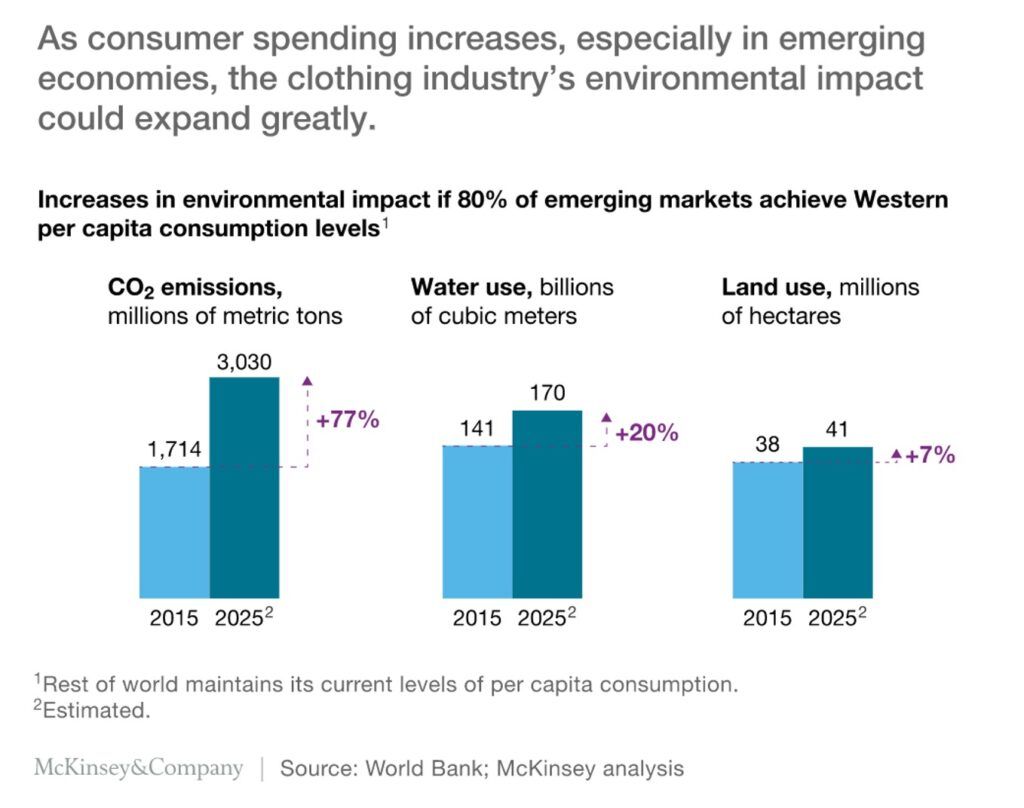The rise of e-commerce and social media in the past decade has transformed the fashion industry. There is currently a huge gap between how slow it is to produce clothes and how fast trends come and go. With social media, shoppers see every new trend, the moment it appears.
However, this traditional manufacturing model (brands invest a lot of money up front to design and produce a big collection → they send large orders to factories (often overseas) → the process takes months → and in those months, consumers have moved on to new things) not only failed to acknowledge the impact on the environment but might NOT be the go-to option in the future.
Why?
COVID-19.
The Coronavirus has tremendously impacted the fashion industry – everything has been affected, from sales to press to production.
Retailers such as Zara have closed their stories, moving to digital means. Additionally, fashion show events were cancelled as mass gatherings were prohibited to prevent the spread of the virus. The challenge retailers faced was how to stay relevant when there’s been such a fundamental change in the whole world. To combat this, brands will have to be more online-centric and create visual settings for their customers. This has already begun with virtual clothing, virtual catwalks, and virtual showrooms becoming more common. However, one of the biggest challenges for sellers is now how to keep their prices low when there’s a higher cost of production.
Their struggle began early as most products are manufactured in China, the problem began to arise when factories had to be closed, so that made it impossible to commerce the production for orders that were already placed. International shipping was an issue as well as Cargo loading takes much longer due to sanitation and more thorough checking. In some cases, some places had to opt for air freight shipping to save time though it increases cost. Moreover, there is no income but there is a lot of outgoing, rent of the retail stores, salaries for the employees. However, some shopping malls have been helpful in waiving rentals.

On the other hand, from the consumers perspective, their habits have changed too as their priorities have shifted. People are only focusing on essentials, so the thought of buying new clothes feels frivolous. Changes in shopping patterns and a slower markert might mean customers might opt for slow fashion rather than fast fashion. This combined with the increase in the demand for products from a truly sustainable supply chain will change the fashion industry as we know it.
However, does COVID-19 mean the end of fast fashion?
COVID-19 might just be the catalyst the industry needs to become a more sustainable and ethical industry.
According to the 2019 Global Wellness Trend report, fashion is the world’s most destructive business sectors, and the world’s second worst offender when it comes to water pollution and it is responsible for approx 10% of all carbon emissions. In the last 20 years, the amount of clothes produced by fashion brands has doubled.
Experts say that going back to business as usual is not an option, so the requirement to integrate all forms of digitisation from the supply chain and creation, to showcasing and retailing is forcing every brand to embrace the technologies that empower this. This means consumers behaviour changes will depend on new experiences being adopted by brands.
The Fabricant – an outdoor lifestyle brand has created digital clothing samples in place of physical ones, eliminating textile waste and creating stunning online content in the process. Their new LEELA platform (https://digital.fashion/) is their big step to becoming digital. It was put out there regardless of its level of readiness so that they could begin engaging with early adopters and enthusiasts.
Regarding brands preparing themselves for the changing consumer sentiment, experts have said demonstrating eco-ethical credentials, socially positive actions, and networks of support (which have become far more visible during this pandemic) will need to be far more emphatic.
“Purpose will increasingly conflate with performance”
Consumers are watching and deciding on which brand aligns with their social, political and spiritual worldviews – companies are branding themselves with every decision they make and every action they take. One major aspect consumers are looking at nowadays is a company’s treatment of their workers. It is inevitable that all of us would think companies should not be putting their profits or productivity ahead of people’s health and safety. However the reality is, as long as consumption is part of our economy, marginalised people’s health and safety – if they can afford medical care, housing, even food – is directly tied to the supply chain. Garment workers are some of the most marginalised, unprotected people on earth. Hitting the reset button on sustainable production or resale is possible but you can’t hit the reset button on human life.
So what’s next?
We should use this time to find ways to protect factory workers WHILE doing better for the planet.
We should be conscious and compassionate consumers.
We should use this opportunity to refine business models and build a more sustainable, progressive future for the fashion industry.
References:
- https://www.businessoffashion.com/articles/intelligence/the-state-of-fashion-2020-coronavirus-update-bof-mckinsey-report-release-download
- https://www.worth.com/how-the-current-crisis-could-impact-the-future-of-fashion-forever/
- https://www.forbes.com/sites/brookerobertsislam/2020/04/06/virtual-catwalks-and-digital-fashion-how-covid-19-is-changing-the-fashion-industry/#50faf26b554e
- https://www.euronews.com/living/2020/04/10/experts-call-for-total-abandonment-of-fast-fashion-to-prevent-environmental-disaster
- https://www.mckinsey.com/business-functions/sustainability/our-insights/style-thats-sustainable-a-new-fast-fashion-formula
- https://fashionunited.uk/news/fashion/top-10-challenges-facing-fashion-in-2020/2019123046802
